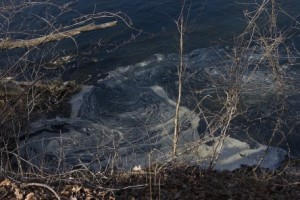Perhaps you welcomed last week’s daily rainfall in the Mid-Atlantic as a cool respite from August heat. Or maybe you resented it for disrupting your vacation. Your flowers probably loved the regular watering, even if your tomatoes craved more sunlight.
Beach days notwithstanding, most of us consider summer rain to be a good thing. But any time heavy rain falls on hard surfaces in developed areas, stormwater runoff carries pollution into waterways. According to the Chesapeake Bay Program, stormwater runoff is the fastest growing source of pollution to the Bay and its rivers, and accounts for 15% of its nitrogen pollution. When rain hits rooftops, parking lots and roads, instead of forests, meadows and wetlands, it rushes directly into storm drains connected to local waterways. Along the way it picks up sediment, excess nutrients such as nitrogen and phosphorus, and other chemicals, giving them an express ride into rivers and ultimately, the Bay.

Development makes this problem worse in two ways: First, it increases the amount of pollution in the watershed by increasing construction, cars, sewage, and lawn fertilizer – major sources of sediment and nutrients. Second, it reduces the area available for rainwater to soak into the ground, slow down, and be filtered before entering waterways. Wetlands and other natural habitats can hold excess water in place, allowing sediment to fall out and plants to absorb nutrient pollution. But with high pollution levels and little filtering, excess nutrients wash downstream and trigger algal blooms in the Bay. Eventually, as the algae die and decompose, they remove oxygen from the water, creating a dead zone. Scientists from the Virginia Institute of Marine Sciences recently confirmed that when the dead zone pops up each summer, the fish leave.
But not all the effects of polluted runoff occur far downstream. When 25 percent of the land surface in a watershed gets covered in pavement or other impervious surfaces, rivers and streams lose most of their biological diversity. And with fewer natural filters to slow water down, local flooding can increase, damaging homes and creating hazards.
Some regional and national conservation groups, including the Shenandoah and Potomac Riverkeepers, want the EPA to do more to reduce polluted runoff. They filed petitions this summer asking the EPA to use its authority under the Clean Water Act to require commercial, industrial and other sites to take steps to reduce their runoff. Green infrastructure techniques such as green roofs, rain gardens and permeable pavements mimic natural habitat like forests and meadows by allowing rainwater to be absorbed in soil and taken up by plants. Green roofs on office or apartment buildings, for example, are covered in soil and plants instead of asphalt, capturing rainwater and often cooling buildings at the same time. Rain gardens provide shallow vegetated basins to capture runoff before it rushes into storm drains.
This week, the weather in Berryville VA (where TDP is based) looks to be a bit more typical for August: chance of thunderstorms in the afternoon and evening, sunny or partly cloudy the rest of the time. Hopefully, with green infrastructure in place for development and best management practices on farms, (which are also a source of sediment and nutrients), soon no one will have to fear the occasional rainy week. Except, of course, at the beach.


One thought on “Rain Rain Go Away? Not with Green Infrastructure.”